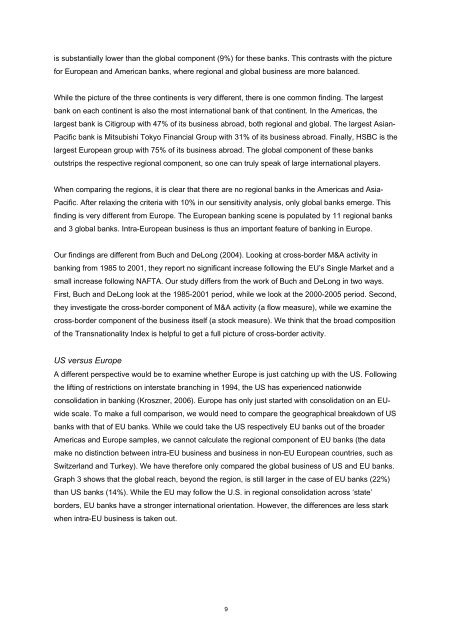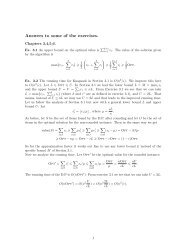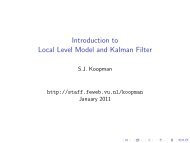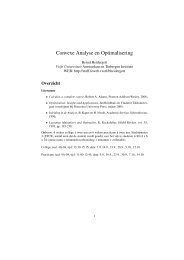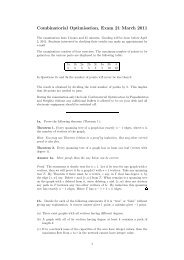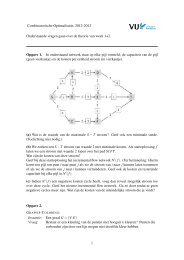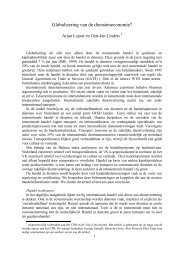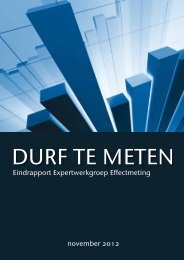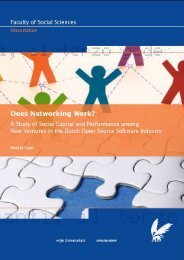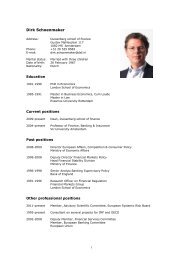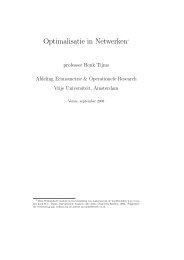Current State of Cross-Border Banking - Vrije Universiteit Amsterdam
Current State of Cross-Border Banking - Vrije Universiteit Amsterdam
Current State of Cross-Border Banking - Vrije Universiteit Amsterdam
You also want an ePaper? Increase the reach of your titles
YUMPU automatically turns print PDFs into web optimized ePapers that Google loves.
is substantially lower than the global component (9%) for these banks. This contrasts with the picture<br />
for European and American banks, where regional and global business are more balanced.<br />
While the picture <strong>of</strong> the three continents is very different, there is one common finding. The largest<br />
bank on each continent is also the most international bank <strong>of</strong> that continent. In the Americas, the<br />
largest bank is Citigroup with 47% <strong>of</strong> its business abroad, both regional and global. The largest Asian-<br />
Pacific bank is Mitsubishi Tokyo Financial Group with 31% <strong>of</strong> its business abroad. Finally, HSBC is the<br />
largest European group with 75% <strong>of</strong> its business abroad. The global component <strong>of</strong> these banks<br />
outstrips the respective regional component, so one can truly speak <strong>of</strong> large international players.<br />
When comparing the regions, it is clear that there are no regional banks in the Americas and Asia-<br />
Pacific. After relaxing the criteria with 10% in our sensitivity analysis, only global banks emerge. This<br />
finding is very different from Europe. The European banking scene is populated by 11 regional banks<br />
and 3 global banks. Intra-European business is thus an important feature <strong>of</strong> banking in Europe.<br />
Our findings are different from Buch and DeLong (2004). Looking at cross-border M&A activity in<br />
banking from 1985 to 2001, they report no significant increase following the EU’s Single Market and a<br />
small increase following NAFTA. Our study differs from the work <strong>of</strong> Buch and DeLong in two ways.<br />
First, Buch and DeLong look at the 1985-2001 period, while we look at the 2000-2005 period. Second,<br />
they investigate the cross-border component <strong>of</strong> M&A activity (a flow measure), while we examine the<br />
cross-border component <strong>of</strong> the business itself (a stock measure). We think that the broad composition<br />
<strong>of</strong> the Transnationality Index is helpful to get a full picture <strong>of</strong> cross-border activity.<br />
US versus Europe<br />
A different perspective would be to examine whether Europe is just catching up with the US. Following<br />
the lifting <strong>of</strong> restrictions on interstate branching in 1994, the US has experienced nationwide<br />
consolidation in banking (Kroszner, 2006). Europe has only just started with consolidation on an EUwide<br />
scale. To make a full comparison, we would need to compare the geographical breakdown <strong>of</strong> US<br />
banks with that <strong>of</strong> EU banks. While we could take the US respectively EU banks out <strong>of</strong> the broader<br />
Americas and Europe samples, we cannot calculate the regional component <strong>of</strong> EU banks (the data<br />
make no distinction between intra-EU business and business in non-EU European countries, such as<br />
Switzerland and Turkey). We have therefore only compared the global business <strong>of</strong> US and EU banks.<br />
Graph 3 shows that the global reach, beyond the region, is still larger in the case <strong>of</strong> EU banks (22%)<br />
than US banks (14%). While the EU may follow the U.S. in regional consolidation across ‘state’<br />
borders, EU banks have a stronger international orientation. However, the differences are less stark<br />
when intra-EU business is taken out.<br />
9


